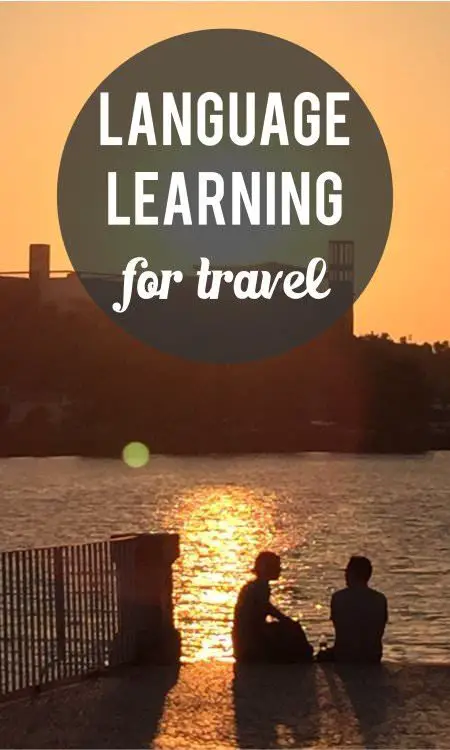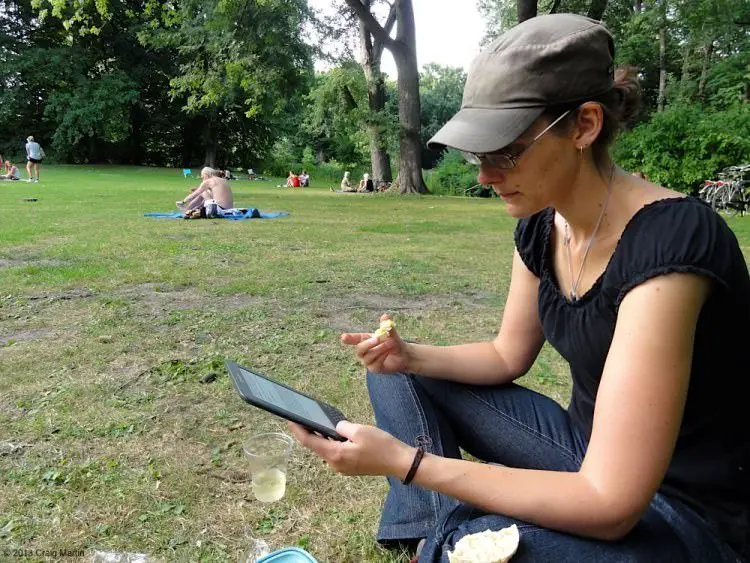
We aren’t naturals at language learning, but we have learned Spanish to a satisfying level of fluency. If we can do it, you can too — have a listen to the podcasts below, or check out some of the resources listed in this post.
Language learning podcasts
Resources for many languages
Fluent in three months
Benny Lewis, otherwise known as the Irish Polyglot, has a great series of resources available on his site. He’s taught himself countless languages over the years, so he’s a great inspiration!
Speaking
If you’re learning a language to travel, your main goal will be communication — speaking! No matter how much you read or how many grammar activities you do, or how much vocabulary you understand; if you want to speak to people, you have to speak.
Learn a few set phrases and use them! If you don’t understand the responses at first, that’s no real problem — just get started. Opening your mouth is the biggest hurdle for a lot of people, so get past that problem as soon as possible.
We found it helpful to chat through instant messaging at first, talking to native speakers we met in language-learning communities like italki, then move to Skype calls. You can also sign up to classes through these communities and at Verbling, or you could do a conversation exchange in person if you prefer the face-to-face approach. Conversationexchange.com is great for meeting language-exchange partners.

Listening
Surround yourself with the language you’re learning. Listen to music, watch TV shows or videos, have fun! Make sure to have a mix of background sound and conscious close-learning activities, so that you can train your ear to pick up the words of the language. Lyricstraining is a fun way to practice listening! You could also find audiobooks on Librivox or Audible. Your local library might even have some graded readers with CDs attached that can be useful for language learning.
Reading
If you like to read in English, make a habit of reading in the language you’re learning as well. Be careful to choose books and articles that you find interesting, because if you’re bored by what you’re reading, chances are that you’ll give up on it.
There are four types of reading, and it’s a good idea to practice all of them. Skimming is reading quickly to get a general idea of the text, such as when you read the summary of a book before deciding if you want to read the whole thing. Scanning is also a way of reading quickly, but in this case you’re looking for a piece of information, like when you check a bus timetable for the next departure. Intensive reading is the type of reading you’ll often find in language classes, where you have to read carefully to completely understand a text – you’ve probably done this type of reading in English exams.
Another type of reading is extensive reading, which means you read a long text but not in an intensive way. When you read a novel, you usually read extensively — you’re not studying, but you’re (hopefully) enjoying reading. While scanning, skimming and intensive reading are good skills to practice, extensive reading is the most important. It’s a good idea to create the habit of reading for half an hour each day in your target language — but to do this, you have to enjoy what you’re reading. You can use graduated books that are easier versions of normal books, or you can read books for children or teenagers. I read romance novels when I was learning Spanish because they were very easy to read!
Check out your local library for graded readers, or subscribe to your library on your phone using the Overdrive app. You can also find free ebooks in different languages at Project Gutenberg or ebook.bike. Children’s books are available in French and Spanish are available at Reading A-Z, and short stories in many languages can be found at BookBox.

Writing
Some people think that writing isn’t important when learning a new language, but they’re wrong. We write a lot in our native language: from Facebook statuses, to emails, to shopping lists. Plus, writing can be a great way to process what you’ve learned during the day.
Create a habit of writing regularly so that you can practice as much as possible. You could keep a diary in your new language or start a blog about what you’ve been learning. I found that chatting by instant message (for example using Facebook chat) was a good way to practice writing and the language of conversation at the same time — and it’s easier than speaking in person because you have time to think before answering a message.
You can find people to chat with in communities like Italki, which also allows you to submit texts you’ve written and other users will correct them for you. The idea is that you correct texts by other users who are learning your native language. LingQ and Busuu are other pages in which other users edit your texts.
Vocabulary
Learning new words is really important, but it’s a good idea to make the task fun by using apps like Duolingo or Busuu. These apps divide the language into units, and you can earn prizes for studying — and everyone likes prizes, right?
It’s a good idea to use a monolingual dictionary (in the language you’re learning only) to help you think as much as possible in your target language. Wordreference.com is a good choice.
You can also use a dictionary to translate between your language and the one you’re learning — SpanishDict is a good choice for Spanish learners. You should also create a personal dictionary in your phone or in a notebook. I found that a notebook is better because the act of writing helps you learn the words. Buy a small one and take it with you everywhere you go so that you can check your words at any time of day.
Another way of studying during the day is using spaced repetition programs such as Anki, which you can study on your computer or your mobile phone. There are many ways to study vocabulary, you have to find the best way for you and do as much as possible! Other options are studying lists of common words or watching videos on YouTube.

Grammar
The problem with many language courses is that they include too much grammar! If you’re doing a language course, you probably don’t need to study more of this at home, you’ll get enough in class. Remember that making grammatical mistakes is not the end of the world; and grammar is not the most important thing to learn — it is much more important to talk! However, if you’re learning alone, or if you enjoy learning rules, you might need to study a little grammar.
I bought a series of Spanish grammar books, and tried to do a few units a week, and I found this really helpful. Otherwise, do a google search for “online grammar exercises” and the language you’re learning, and you’re sure to find a wealth of resources.

Resources for learning Spanish
Pronunciation
Pronunciation is key when learning Spanish! Check out the University of Iowa’s excellent resource for understanding Spanish pronunciation.
Vocabulary
A list of most-common words is a good way to find words to learn. RAE and Eduteka both have lists to check out.
Listening
News in slow Spanish is a great way to hear the news and learn Spanish at the same time.
Reading
There are plenty of resources out there for reading in Spanish, such as graded readers, children’s books, a children’s book library, fairy tales, parallel texts, and free ebooks from ebook.bike and Gutenberg.
If you want to practice intensive reading, check out this Spanish reader and this one from 1920.
Grammar
I found it helpful to buy a Spanish grammar book, and tried to do a few units a week. You can also check out the Spanish Grammar Guide, or do exercises online at Todo Claro.
Level test and exams
If you’re interested in seeing what level your Spanish is at, try this online test. If you want to do an official exam (DELE), or just find resources for these exams, Cervantes.es is the place to go.
